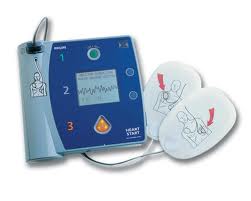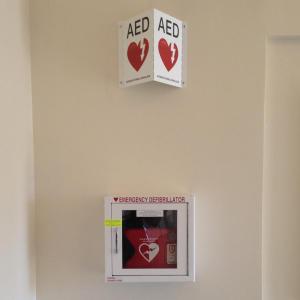An automated external defibrillator or AED is a device that is used on a unconscious victim during cardiac arrest to help restart the victim’s heartbeat. When hooked up to a victim, the device analyzes the rhythm of the heart and will deliver an electric shock if necessary.
AED’s are portable devices that can be found in public places such as malls, airports, schools, office buildings, hotels, etc. You should always be aware of the location of the nearest AED. It might save someone’s life.
During cardiac arrest or the loss of heart function, a person can only survive for a couple minutes. When the heart is not beating, blood can’t flow to the brain and/or other vital organs. Cardiac arrest can occur for a number of reasons like arrhythmia (abnormality in the heart rhythm) or heart disease. The AED uses an electric shock to start the heart beating again and is meant to be used during CPR. In most cases, the electric shock should immediately be followed by CPR chest compressions.
AED’s can be used on adults, children, and infants. The placement of the pads is different depending on the age of the victim and the pads will have a diagram letting you know where to put the pads. Age groups are defined as:
- Infant – Birth to one year old. One pad is placed on the chest and the other on the back with the heart between them.
- Child – One year old until the age of 8. Pads go on the upper right chest area and lower left side with the heart directly between them.
- Adult – Older than 8. Pads go on the upper right chest area and lower left side with the heart directly between them.
When to use an AED
AED’s should be used right away when there is an emergency. The quicker you get the defibrillator hooked up to the victim, the higher chance he/she has for survival. While one person is performing CPR, another person should locate the AED. Remember to always call emergency response first.
Preparation
The first thing you should always do during an emergency is assess the situation and call emergency response. This is 9-1-1 in most places. Once an AED is brough to the scene, it should be used right away.
- Place the AED by the victim’s shoulder,
- Position the victim away from contact with metal or water. Make sure the scene is safe; no toxic or flammable fumes, keep the victim away from water (this may come into play if the victim is pulled from a pool or pond, etc.
- If the victim is wet, dry the chest area.
- Turn on the AED by pressing the power button (this is usually colored green)
Once the AED is on, the device will instruct you through the process with words. The video below will show the AED process on an adult.
Please not that different brands use different instructions but the general procedure is the same.
The use of an AED as well as the entire CPR process is covered in the FREE CPR/BLS Course offered by American BLS. Create an account and take the free course today and learn how to react during an emergency and save the lives of those around you.


